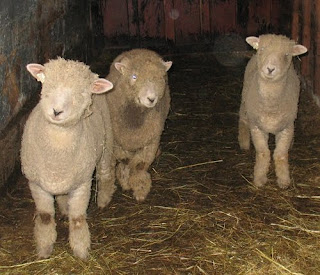
Soups, stews and homemade bread make great suppers for snowy winter days. I'd like to share a method for making lamb stew that I think really brings out the flavor of the meat.
Most stew recipes call for cubing meat in bite size pieces, dredging them with flour and salt and pepper [along with other spices] and then browning them in oil. Once the meat is browned, it usually simmers in stock for an hour or two until the meat is tender. Spices, vegetables and other ingredients enhance the flavor of the meat. The result is delicious!

I used to use that same basic recipe until one day when I used leftover roast and gravy as the basis of a lamb stew. The resulting stew was so much more flavorful. From that time onward, our lamb stew starts out as a roast leg of lamb.
To make this recipe you will need a 4 pound leg of lamb [I get mine boneless - it makes it much easier to cut up], 1 tbsp of fresh thyme chopped, 1 tbsp of fresh rosemary chopped, 1 tsp of salt and some freshly ground pepper. You will also need some flour and lamb stock to make gravy. You will need a metal roasting pan and a rack.
First combine the spices and rub into the lamb. Position the leg on the rack and roast in a 500 degree pre-heated oven for 15 minutes. Lower the oven temperature to 350 degrees and roast for another hour or until a meat thermometer registers 175 degrees.
Remove the roast from the pan, reserving the drippings. Place the roasting pan over a burner set to low. Stir 3 tbsp of flour into the drippings [this is called a roux] and gradually add lamb stock [you can use water or beef broth if you do not have lamb stock], stirring to remove any lumps. Season with salt and pepper to taste.
At this point, the roast and the gravy can be refrigerated for a few days if you wish.

When you are ready to make the stew, cut the roast into pieces removing the gristle and fat. Put the stew pieces into a pot with the gravy. Put the trimmings into a skillet with 1 tbsp of olive oil and sear them until the fat is rendered. Add a quart of water and allow the trimmings to simmer until the liquid is reduced by half.
After the liquid has cooled, add 2 tbsps of flour and whisk it until it is smooth. Add this to the pot with the meat and the gravy. Simmer until the meat and gravy are hot.
Peal and chop 4 large carrots and 4 medium potatoes. Cook the vegetable separately and when they are tender, add them to the stew. Check the seasonings and adjust them to taste.

Tonight I served this stew with a simple boule bread. This recipe makes two loaves.
3 cups warm water
1 tbsp dry yeast
1 tbsp salt
1 t sugar
2 tbsp olive oil
6 - 8 cups flour
Combine the yeast, sugar and warm water and let it sit until it proofs [it will get quite frothy]. Then add 3 cups of the flour and stir. Let it sit for 15 minutes. Add the salt and as much flour is needed to make a nice dough [do not add too much flour or the bread will be heavy and tough. If the dough is too sticky to knead you can incorporate more flour into it]. Put the dough into a lightly oiled bowl and cover with a damp cloth until it has doubled in size - about two hours.
After the first rising, punch the dough down and shape into round loaves. Place the loaves onto a cornmeal covered baking pan and cover with a damp cloth to let it rise again for about a half hour.
Preheat the oven to 450 degrees. Before placing the dough in the oven, mist the tops of the loaves with water or wet you hand and pat the surface of the dough with water [this will make the crust nice and crunchy]. Bake until the tops of the loaves are medium brown - about 35 minutes.
 Cooking Terms:Roux
Cooking Terms:Roux - A roux is a thickener for many sauces and gravys. It is made by combining wheat flour with fat. In the case of our lamb gravy, the fat was animal fat. If you roast a particularly lean piece of meat that does not leave with with generous drippings, you can add butter to them before stirring in the flour.
Proofing - Dry yeast needs warm liquid and sugar to allow it to grow. It is the gas that the yeast gives off during this growth that allows the bread to rise. That is why baking bread goes through so many "resting" stages when we let it "double" in size.

 Remove fresh herbs and pour filling into a casserole dish. Make stuffing. You can use a mix or make your own. I used a mix because I'm just not that motivated. Cover filling with stuffing and bake for 30 minutes. If you want to serve it over mashed potatoes or rice, this would be a good time to make it.
Remove fresh herbs and pour filling into a casserole dish. Make stuffing. You can use a mix or make your own. I used a mix because I'm just not that motivated. Cover filling with stuffing and bake for 30 minutes. If you want to serve it over mashed potatoes or rice, this would be a good time to make it.



































